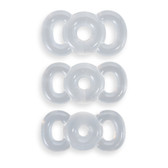 Loading... Please wait...
Loading... Please wait...- Home
- Prostate Cancer ED
Categories
Popular Brands
Prostate Cancer ED
Prostate Cancer ED
Erectile Dysfunction Treatment for Prostate Cancer Impotence
Prostate cancer can lead to impotence through various mechanisms, primarily due to the treatments employed to manage the disease. Surgical removal of the prostate gland, known as a prostatectomy, can damage the nerves and blood vessels essential for achieving and maintaining an erection. Additionally, radiation therapy aimed at the prostate can inadvertently affect nearby nerves and blood vessels, leading to erectile dysfunction. Hormone therapy, commonly used to suppress testosterone levels and slow cancer growth, can also result in decreased libido and difficulty achieving or sustaining erections. The psychological impact of a cancer diagnosis and the stress associated with treatments can further exacerbate sexual dysfunction. Overall, the multifaceted nature of prostate cancer and its treatments underscores the importance of comprehensive care and support for affected individuals, including addressing the potential implications for sexual health.
Treatment for impotence resulting from prostate cancer surgery typically involves various approaches aimed at restoring erectile function. One commonly utilized method is oral medications such as phosphodiesterase type 5 (PDE5) inhibitors, including sildenafil (Viagra), tadalafil (Cialis), and vardenafil (Levitra). These drugs work by increasing blood flow to the penis, facilitating erections. For individuals who do not respond to oral medications, other options like penile injections, vacuum erection devices, or penile implants may be considered. Penile rehabilitation programs, which involve a combination of medications, injections, and/or vacuum devices, aim to improve erectile function and maintain penile tissue health following surgery. Additionally, counseling and psychosexual support play a crucial role in addressing the emotional and psychological aspects of erectile dysfunction post-prostate cancer surgery, helping individuals and their partners navigate this challenging aspect of their recovery journey. Overall, a personalized approach tailored to the individual's needs and preferences is essential in optimizing outcomes and restoring quality of life after prostate cancer surgery-induced impotence.





